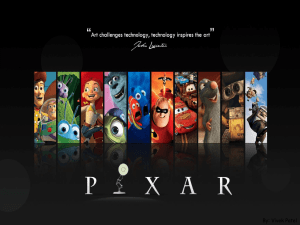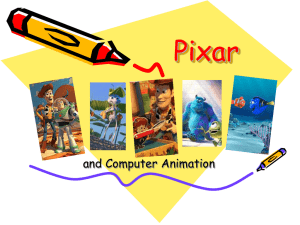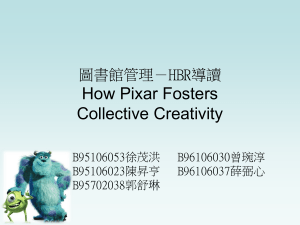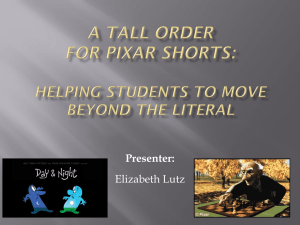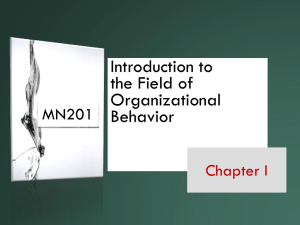Walt Disney Pixar Case Analysis
advertisement
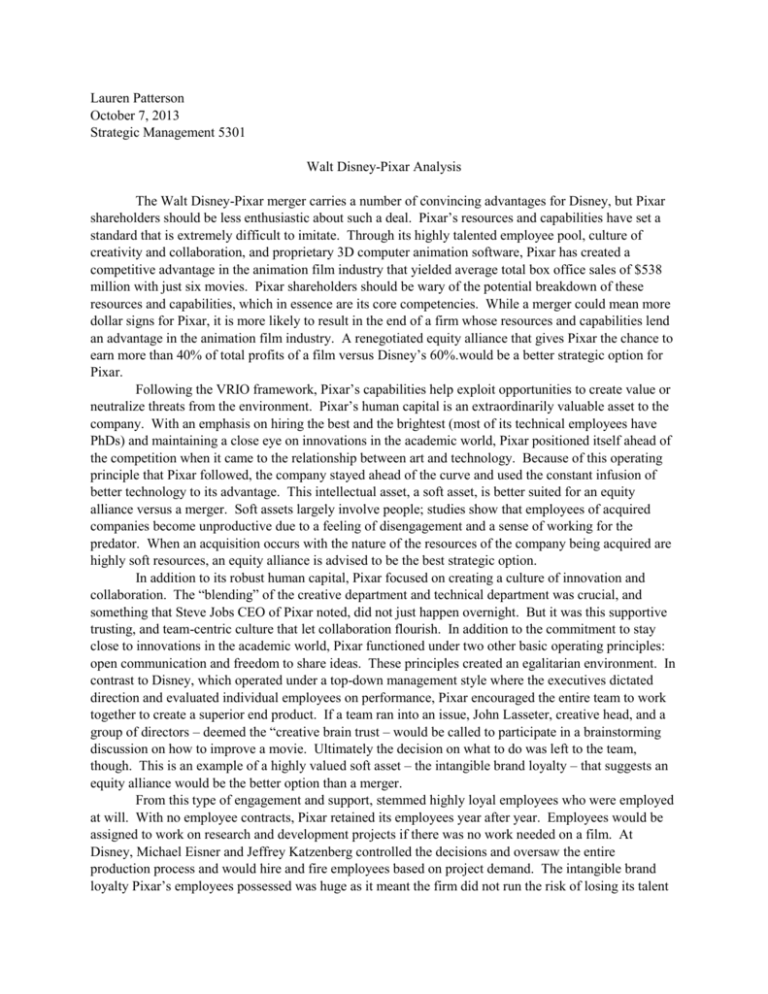
Lauren Patterson October 7, 2013 Strategic Management 5301 Walt Disney-Pixar Analysis The Walt Disney-Pixar merger carries a number of convincing advantages for Disney, but Pixar shareholders should be less enthusiastic about such a deal. Pixar’s resources and capabilities have set a standard that is extremely difficult to imitate. Through its highly talented employee pool, culture of creativity and collaboration, and proprietary 3D computer animation software, Pixar has created a competitive advantage in the animation film industry that yielded average total box office sales of $538 million with just six movies. Pixar shareholders should be wary of the potential breakdown of these resources and capabilities, which in essence are its core competencies. While a merger could mean more dollar signs for Pixar, it is more likely to result in the end of a firm whose resources and capabilities lend an advantage in the animation film industry. A renegotiated equity alliance that gives Pixar the chance to earn more than 40% of total profits of a film versus Disney’s 60%.would be a better strategic option for Pixar. Following the VRIO framework, Pixar’s capabilities help exploit opportunities to create value or neutralize threats from the environment. Pixar’s human capital is an extraordinarily valuable asset to the company. With an emphasis on hiring the best and the brightest (most of its technical employees have PhDs) and maintaining a close eye on innovations in the academic world, Pixar positioned itself ahead of the competition when it came to the relationship between art and technology. Because of this operating principle that Pixar followed, the company stayed ahead of the curve and used the constant infusion of better technology to its advantage. This intellectual asset, a soft asset, is better suited for an equity alliance versus a merger. Soft assets largely involve people; studies show that employees of acquired companies become unproductive due to a feeling of disengagement and a sense of working for the predator. When an acquisition occurs with the nature of the resources of the company being acquired are highly soft resources, an equity alliance is advised to be the best strategic option. In addition to its robust human capital, Pixar focused on creating a culture of innovation and collaboration. The “blending” of the creative department and technical department was crucial, and something that Steve Jobs CEO of Pixar noted, did not just happen overnight. But it was this supportive trusting, and team-centric culture that let collaboration flourish. In addition to the commitment to stay close to innovations in the academic world, Pixar functioned under two other basic operating principles: open communication and freedom to share ideas. These principles created an egalitarian environment. In contrast to Disney, which operated under a top-down management style where the executives dictated direction and evaluated individual employees on performance, Pixar encouraged the entire team to work together to create a superior end product. If a team ran into an issue, John Lasseter, creative head, and a group of directors – deemed the “creative brain trust – would be called to participate in a brainstorming discussion on how to improve a movie. Ultimately the decision on what to do was left to the team, though. This is an example of a highly valued soft asset – the intangible brand loyalty – that suggests an equity alliance would be the better option than a merger. From this type of engagement and support, stemmed highly loyal employees who were employed at will. With no employee contracts, Pixar retained its employees year after year. Employees would be assigned to work on research and development projects if there was no work needed on a film. At Disney, Michael Eisner and Jeffrey Katzenberg controlled the decisions and oversaw the entire production process and would hire and fire employees based on project demand. The intangible brand loyalty Pixar’s employees possessed was huge as it meant the firm did not run the risk of losing its talent – the creative and technical masterminds behind the box office hits. As with the strong cross-functional relationships, this brand loyalty is extremely difficult to imitate and both are social complexities that offer a competitive advantage to the firm. Another unique advantage Pixar has over other studios is its three proprietary (patented) technologies: RenderMan, Marionette, and Ringmaster. RenderMan enhanced texture and color to 3D computer generated models, which in itself were revolutionary compared to the traditional 2D animation. These software programs gave Pixar the capability to easily change a scene or a character all through mathematical models. This capability proved to be a huge time saver and subsequently a cost advantage over other studios that used 2D animation, which was very time intensive and needed a large staff of drawers. As an example, Pixar produced Toy Story in 1995 with only 110 staff and $3 million in general and administrative operating expenses. And since time was saved on the animation, the team could spend more time on the storyline and building out the characters, which resulted in high quality films. Marionette and Ringmaster enhanced character animation and production management respectively. These internal technological capabilities are a major reason why Pixar was able to produce such successful films at the box office. The blue ocean innovation of the animation software proved to be very costly for other studios to imitate, and Disney eventually reverted back to focusing on 2D film projects. Therefore, the quality of the films produced by Pixar were unmatchable. And because these software technologies were proprietary, it meant they could not be bought in the marketplace. The only way to imitate was for a studio to try to imitate the capabilities, which would be very costly. Because of these three major capabilities (human capital, collaborative culture, technological resources), Pixar holds a firm competitive advantage over other studios in creating animated films. Looking at whether these capabilities are sustainable though is the question. Pixar needs to recognize that technology is constantly innovating and in due time, capable competition will exist. DreamWorks is the biggest threat to Pixar’s capability and has enjoyed great success with the production of Shrek and its sequel, Shrek 2, which brought in $919 million in total box office sales. Between 1998 and 2005, DreamWorks had a number of successful computer generated releases and averaged $317 in box office sales. However, this was still over $200 million less than what Pixar was experiencing. Pixar’s other two core competencies are harder to imitate and have bigger barriers to transferability. Pixar’s organizational routines, team‐embodied skills, and brand loyalty construct a core competency that are not about the product per se, therefore much harder for other firms to replicate. Pixar maintains a sustainable competitive advantage that risks being defunct if a merger with Disney were to occur. Shareholders should recognize that Pixar’s value comes from its human asset and ability to innovate and collaborate. It is quality over quantity. Lastly, a merger would mean the dissolution of Pixar stock which at the Pixar’s reliance on Disney rested solely on Disney’s ability to distribute the films. Rather than a merger, which raises a lot of red flags due to Pixar’s highly valuable soft assets, Pixar needs to focus on creating an equity alliance with Disney. The firms are also deriving sequential synergies: Pixar produces the film, Disney distributes the film. This is another indicator according to the framework presented in the article “When to Ally and When to Acquire” that an equity alliance is the better strategic option. Competition for resources will start to move up as more and more people are becoming skilled in computer generated animation. However, Pixar will likely maintain its ability to attract the best, resulting in competition never reaching much above a medium level. Therefore, this is another indicator that an equity alliance is the best option for Pixar and Disney as set forth in the collaboration framework. What Pixar needs to focus on in a renegotiated equity alliance is a greater equity stake in the multiple revenue streams that Disney has and lower distribution fees, most importantly capitalizing on its theme parks and resorts. A merger would benefit Disney as it looks to increase its shareholder value, but for Pixar it means the dissolution of valuable stock. Disney should also be cautious of the potential mass exodus of Pixar’s creative talent due to a merger, leaving Disney with nothing of much value at all. Exhibit 1 Exhibit 8 Exhibit 9 Exhibit 10 Work Cited Alcacer, Juan, David Collis, and Mary Furey. “Walt Disney and Pixar: To Acquire or Not to Acquire?” Harvard Business School. #9-709-462 January 2010. Dyer, Jeffrey H., Prashant Kale, and Harbir Singh. “When to Ally & When to Acquire.” Harvard Business Review. July 2004. Prahalad, C.K. and Gary Hamel. “The Core Competence of the Corporation.” Harvard Business Review. May – June 1990.
